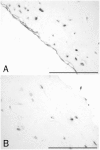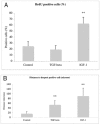In vitro healing of avascular meniscal injuries with fresh and frozen plugs treated with TGF-beta1 and IGF-1 in sheep
- PMID: 18787623
- PMCID: PMC2480574
In vitro healing of avascular meniscal injuries with fresh and frozen plugs treated with TGF-beta1 and IGF-1 in sheep
Abstract
We studied the effect of freezing and inserting meniscal plugs in lesions generated in the avascular area of sheep menisci maintained in vitro, and whether the healing process can be improved by adding growth factors TGF-beta1 and IGF-1. Thirty six menisci obtained from healthy 3 months-old sheep were cultured in 6 well plates and holes were perforated in the avascular area. Meniscal plugs, either fresh or frozen at -20 degrees C for 1 month, were used to fill in the lesions, and then cultured in the presence or absence of TGF-beta1 or IGF-1 for 8 weeks. Samples stained with Massons trichrome were analyzed to evaluate the attachment of the plug and the cell density of the tissue. BrdU immunohistochemistry was performed to identify the proliferation of meniscal cells. Both growth factors improved considerably the cell density of implanted plugs. TGF-beta1 increased significantly the attachment of both fresh and frozen plugs, but it had no effect on meniscal cell proliferation. In contrast, IGF-1 had no effect on the attachment, but did increase significantly the number of proliferating cells in the surface of the host meniscus and the inserted plug. In conclusion, frozen plugs can survive if treated with either TGF-beta1 or IGF-1. The combination of TGF-beta1 and IGF-1 could aid in the repairing of the avascular meniscal injuries, as they are capable of promoting the attachment of tissue, and increasing the proliferation of meniscal cells.
Keywords: IGF1; TGF-β1; avascular injury; meniscus; sheep; tissue engineering.
Figures





References
-
- Arnoczky SP. Building a meniscus – biologic considerations. Clin Orthop. 1999;367(suppl):S244–S253. - PubMed
-
- McDevitt CA, Webber RJ. The ultrastructure and biochemistry of meniscal cartilage. Clin Orthop. 1990;252:8–18. - PubMed
-
- Ghadially FN, Wedge JH, Lalonde JM. Experimental methods of repairing injured menisci. J Bone Joint Surg (Br) 1986;68B:106–110. - PubMed
-
- Guisasola I, Vaquero J, Forriol F. Knee immobilization on meniscal healing after suture: an experimental study in sheep. Clin Orthop. 2002;395:227–233. - PubMed
-
- Roeddeker K, Muennich U, Nagelschmidt M. Meniscal healing: a biomechanical study. J Surg Res. 1994;56:20–27. - PubMed
LinkOut - more resources
Full Text Sources
Miscellaneous
